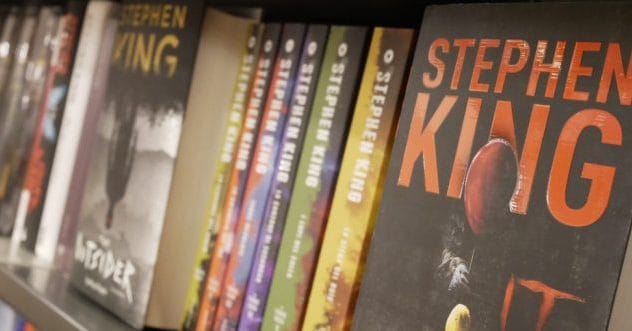Stephen King isn’t just the master of horror; he’s a maestro of misdirection. His novels are legendary, but his short stories often pack the most surprising punches, delivering sharp, unexpected turns that can leave you reeling. King has a unique talent for luring readers into a seemingly familiar scenario, only to pull the rug out from under them with a shocking revelation. Get ready to explore ten tales where King plays with our expectations, leading us down one path only to reveal something entirely unexpected. These are the twists that left readers stunned and rethinking everything they thought they knew.
10. “Under the Weather”
From the collection Bazaar of Bad Dreams, this story begins with deceptive simplicity. We meet Brad Franklin, a middle-aged man starting his day. His wife, Ellen, is unwell and stays in bed. Brad heads to the office, his mind drifting to Ellen and her heart condition. He even recalls her unsettling words: if she died, he’d likely use his imagination to pretend she was still alive. This little memory plants a tiny seed of unease.
The ordinary narrative takes a sharp turn when the building superintendent calls Brad about a foul odor emanating from his apartment. Returning home, Brad discovers a horrifying scene: his dog seems suspiciously satisfied, and his wife’s hand is partially consumed. The gut-wrenching twist is that Ellen wasn’t merely sick; she had been dead all along. The quiet, almost mundane opening makes the tragic and gruesome reveal all the more shocking.
9. “Blockade Billy”
Also featured in Bazaar of Bad Dreams (and released as a standalone novella), “Blockade Billy” initially presents as a charming baseball yarn. An elderly coach reminisces about a talented player, Billy Blakely, from many years past. King masterfully crafts a folksy, nostalgic tone that draws you into the world of classic Americana and baseball lore.
However, subtle dark undertones begin to surface, hinting that there’s more to Billy than meets the eye. The narrator eventually unveils the chilling truth: the man known as Billy Blakely is an imposter named Eugene Katsanis. Katsanis, a former worker on the real Blakely family farm, had horrifically murdered the entire family and assumed young Billy’s identity to pursue a baseball career. The story shifts from a fond remembrance to a tale of horrifying deception.
8. “Strawberry Spring”
Published in King’s first short story collection, Night Shift, “Strawberry Spring” is a prime example of his skill in creating chillingly unreliable narrators. These are storytellers who, for various reasons like mental instability or deliberate deceit, cannot be trusted to convey the facts accurately.
Our unnamed protagonist recounts a peculiar period from his college days eight years prior. A rare, foggy weather phenomenon known as a “Strawberry Spring” coincided with a series of murders on campus by a killer dubbed “Springheel Jack.” As the narrator describes the events, attributing the crimes to this mysterious figure, he fondly recalls the eerie, almost magical atmosphere of that foggy season. The shocking twist arrives when he reveals that both the Strawberry Spring and Springheel Jack have returned, leading the reader to the horrifying realization that the narrator himself is the killer, lost in his own distorted perception of the past and present.
7. “The Boogeyman”
Another unsettling tale from Night Shift, famously adapted into a film, “The Boogeyman” explores parental fears and hidden monsters. The story unfolds as Lester Billings recounts the tragic deaths of his three young children to a psychiatrist, Dr. Harper. Billings insists that a malevolent creature, a boogeyman hiding in closets, is responsible for their deaths.
Throughout Billings’s narrative, the reader naturally suspects that he might be the actual culprit, perhaps projecting his guilt onto a supernatural entity. However, King delivers a classic twist in the final moments. After his appointment, Billings briefly leaves but returns to the office, only to confront a decaying, monstrous figure holding a Dr. Harper mask. This ambiguous ending forces the reader to question everything: Was the psychiatrist the boogeyman all along, or has Billings, now the final narrator, descended further into madness, making his perception unreliable?
6. Nightmares and Dreamscapes Duo: “You Know They’ve Got a Hell of a Band” and “Rainy Season”
The 1993 collection Nightmares and Dreamscapes is packed with eerie gems. King often explores the theme of ordinary people stumbling into strange, nightmarish towns, and two stories here exemplify this perfectly. In “You Know They’ve Got a Hell of a Band,” a young couple on a road trip takes a wrong turn and ends up in a town called Rock and Roll Heaven, Oregon. The twist? It’s literally populated by deceased rock legends who aren’t too keen on letting visitors leave.
Similarly, “Rainy Season” introduces a young couple looking for a fresh start in the small, idyllic Maine village of Willow. Upon arrival, locals cryptically warn them about the impending “rainy season” and advise them to leave and return the next day. Dismissing it as a prank, they decide to stay. That night, the sky opens, but it’s not water that falls. Instead, sharp-toothed, grotesque frogs rain down, invade their home, and ultimately kill them. An invasion of killer amphibians is certainly a twist only King could deliver with such visceral effect, turning a quaint setting into a scene of bizarre horror.
5. “Popsy”
Also from Nightmares and Dreamscapes, “Popsy” masterfully subverts a typical child kidnapping scenario, flipping it into a tale of monstrous, yet strangely satisfying, retribution. Our narrator, Sheridan, is not unreliable; he’s disturbingly frank about his profession: kidnapping children to pay off his gambling debts to a sinister figure known as Mr. Wizard, who deals in more than just cards.
After snatching a young boy from a mall, Sheridan dismisses the child’s repeated warnings that “Popsy” will come for him. He imagines Popsy as a frail old man. However, as he drives, he hears something land on the roof of his van. The chilling twist is that Popsy is far from the harmless grandfather Sheridan pictured. He’s a powerful, winged creature of the night—a vampire. In a gruesome finale, Popsy rescues his grandson, and the two share a grim feast on Sheridan. Even vampires, it seems, cherish their grandchildren.
4. “L.T.’s Theory of Pets”
First appearing as an audio recording and later in the collection Everything’s Eventual, “L.T.’s Theory of Pets” cleverly blends humor and horror, but with a reverse twist. Many King stories start light and turn dark, but this one gives you the grim news upfront: L.T.’s wife, Lulubelle, is missing, likely a victim of a serial killer.
The narrative then shifts, almost becoming a comedy, detailing L.T.’s amusingly frustrating “theory of pets” and the domestic squabbles he and Lulubelle had over their dog and cat. L.T.’s laid-back, anecdotal storytelling style is so engaging that the reader almost forgets the tragic premise mentioned at the beginning. The humor and everyday marital spats about pets dominate the story, lulling you into a sense of normalcy. The twist is the brutal return to reality at the end: Lulubelle’s abandoned car was found, her dead dog nearby, and she is presumed to be the final victim of the infamous Axe Man. The initial horror, softened by humor, comes crashing back with full force.
3. “Autopsy Room Four”
Although filmed for the Nightmares and Dreamscapes miniseries, “Autopsy Room Four” originally appeared in the collection Everything’s Eventual. This tale is a masterclass in suspense, built on a horrifyingly relatable fear: being aware but unable to communicate.
The protagonist, Howard Cottrell, wakes to find himself completely paralyzed, lying on a cold steel table. He quickly realizes he’s in an autopsy room, mistaken for dead. He was found unconscious on a golf course, bitten by a rare (and very fictional) snake whose venom induces total paralysis mimicking death. The story’s tension escalates as medical staff prepare to begin the autopsy. The twist isn’t that Howard is alive—we know that from his internal monologue. The shocking, and darkly comedic, twist is how they discover he’s alive. As a scalpel heads towards a very sensitive area, Howard, in a desperate, primal, and entirely involuntary reaction, gets an erection. This unexpected sign of life startles the coroner just in the nick of time, saving him from a truly gruesome end.
2. “Gramma”
From the 1985 collection Skeleton Crew, “Gramma” is a deeply unsettling story, playing on childhood fears of the elderly and the unknown. After his father’s death, eleven-year-old George and his family move in with his ancient, massive, and bedridden grandmother. Gramma is a source of terror and disgust for George, and he tries to avoid her at all costs.
One stormy evening, George is left alone to care for her. The atmosphere is thick with dread. As George checks on her, he believes Gramma has died. But the relief is short-lived. She suddenly moves, grabbing him. The true horror is revealed: Gramma was a practitioner of dark, occult magic. The twist is that she hasn’t just come back to life; she has used her forbidden knowledge to transfer her consciousness into George’s young body. The story concludes with a chillingly transformed George, now inhabited by Gramma, eagerly awaiting his family’s return, ready to torment them in a new, horrifying way.
1. “Morning Deliveries (Milkman #1)”
Also from Skeleton Crew, “Morning Deliveries” takes an icon of wholesome Americana—the friendly neighborhood milkman—and twists it into something truly sinister. The story opens with a deceptive sense of normalcy. A typical suburban street is waking up, birds are chirping, and Spike Mulligan, the local Cramer’s Dairy milkman, is making his rounds.
The mundane scene slowly begins to curdle. A seemingly throwaway line about Spike reaching around deadly nightshade to grab orange juice is the first subtle clue. Then, things escalate rapidly. Instead of cream, Spike leaves a tarantula at one house. His deliveries become increasingly malevolent: poison, corrosive acid, and even deadly cyanide gas, all disguised in innocuous milk bottles and dairy containers. The twist is the stark realization that this cheerful milkman is a harbinger of death, methodically poisoning an unsuspecting neighborhood. The story ends with Spike driving off into the bright sunshine as a young boy innocently brings in the “milk,” a truly disturbing image of hidden evil in plain sight.
Stephen King’s genius lies not just in scaring us, but in unsettling us with the unexpected. These ten short stories showcase his remarkable ability to craft narratives that are as clever as they are chilling. The twists aren’t mere gimmicks; they often reveal deeper, darker truths about his characters, the fragility of normalcy, and the shadowy corners of the worlds they inhabit. These shocking turns are what make his short fiction so potent, leaving a lasting impression long after the final page is turned.
Which Stephen King short story twist had you completely fooled? Share your favorites and your shocked reactions in the comments below!










